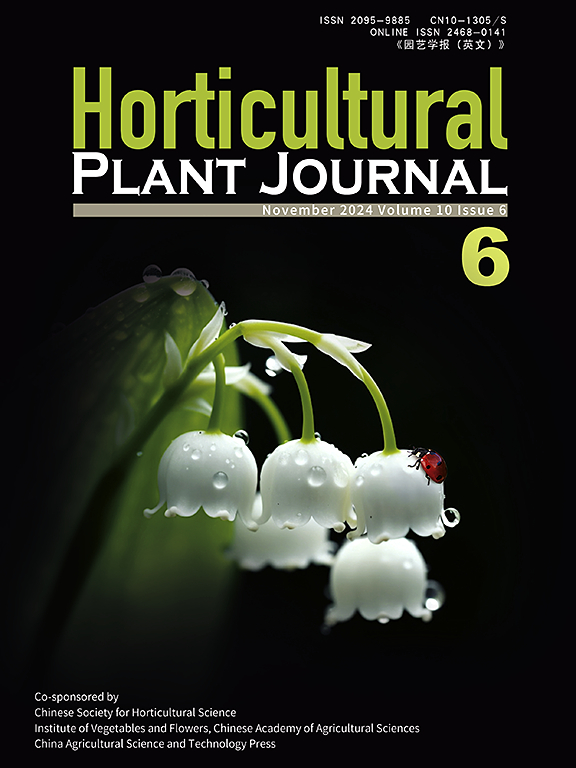MdBAM17, a novel member of the β-amylase gene family, positively regulates starch degradation in ALA-induced stomatal opening in apple (Malus × domestica)
IF 5.7
1区 农林科学
Q1 HORTICULTURE
引用次数: 0
Abstract
5-Aminolevulinic acid (ALA) is a novel plant growth regulator that has shown outstanding capability to promote stomatal opening. Starch degradation, catalyzed by β-amylase (EC3.2.1.2, BAM), plays an important role in stomatal opening. However, whether the starch breakdown is involved in ALA-regulating stomatal movement is unclear. In the current study, we found that exogenous ALA effectively stimulated the starch breakdown in guard cells, increased β-amylase activity and promoted stomatal opening in leaves of apple ( × ). Based on genome-wide identification, we identified a total of 119 members of gene family in ten commonly Rosaceae crops. Analyses of gene structure, motif identification, and gene pair collinearity revealed relative conservation among members within the same group or subgroup. Among these genes, and other 12 genes were identified as the orthologous genes of , which is responsible for starch degradation to modulate the stomatal movement in . RT-qPCR analysis revealed a positive correlation between the expressions of and stomatal aperture, as well as β-amylase activity, whereas a negative correlation was observed with the starch content. Subcellular localization analysis confirmed that MdBAM17 is a chloroplast protein, consistent with the AtBAM1. was mainly expressed in guard cells and responsive to exogenous ALA. Overexpressing increased β-amylase activity and promoted starch breakdown, leading to stomatal opening, which was further strengthened by ALA. RNA-interfering decreased β-amylase activity, resulting in starch accumulation, and impairing the stomatal opening by ALA. However, modulation of expression did not affect the levels of flavonols and HO in guard cells, suggesting that -promoted starch degradation may function at downstream of ROS signaling in the ALA-regulated stomatal opening. Our findings provide new insights into the mechanisms of ALA-regulated stomatal movement.β-淀粉酶基因家族的新成员 MdBAM17 在 ALA 诱导的苹果(Malus × domestica)气孔开放过程中对淀粉降解起积极调节作用
5-Aminolevulinic acid(ALA)是一种新型植物生长调节剂,在促进气孔开放方面表现出卓越的能力。β-淀粉酶(EC3.2.1.2,BAM)催化的淀粉降解在气孔开放过程中起着重要作用。然而,淀粉分解是否参与了 ALA 调节气孔运动还不清楚。在本研究中,我们发现外源ALA能有效刺激苹果叶片(×)中保卫细胞的淀粉分解,提高β-淀粉酶活性,促进气孔开放。通过全基因组鉴定,我们在十种常见的蔷薇科作物中发现了共 119 个基因家族成员。对基因结构、主题识别和基因对共线性的分析表明,同组或亚组内的成员之间具有相对的保守性。在这些基因中,和另外 12 个基因被确定为Ⅳ的同源基因,Ⅳ负责淀粉降解以调节Ⅴ的气孔运动。RT-qPCR 分析表明,Ⅳ和Ⅴ的表达与气孔开度和β-淀粉酶活性呈正相关,而与淀粉含量呈负相关。亚细胞定位分析证实,MdBAM17 是叶绿体蛋白,与 AtBAM1 蛋白一致。过表达增加了β-淀粉酶活性,促进了淀粉分解,导致气孔开放,ALA进一步加强了气孔开放。RNA干扰会降低β-淀粉酶的活性,导致淀粉积累,影响ALA对气孔开放的作用。然而,对表达的调控并不影响黄酮醇和HO在保卫细胞中的水平,这表明-促进淀粉降解可能是ROS信号在ALA调控气孔开放中的下游功能。我们的研究结果为了解 ALA 调节气孔运动的机制提供了新的视角。
本文章由计算机程序翻译,如有差异,请以英文原文为准。
求助全文
约1分钟内获得全文
求助全文
来源期刊

Horticultural Plant Journal
Environmental Science-Ecology
CiteScore
9.60
自引率
14.00%
发文量
293
审稿时长
33 weeks
期刊介绍:
Horticultural Plant Journal (HPJ) is an OPEN ACCESS international journal. HPJ publishes research related to all horticultural plants, including fruits, vegetables, ornamental plants, tea plants, and medicinal plants, etc. The journal covers all aspects of horticultural crop sciences, including germplasm resources, genetics and breeding, tillage and cultivation, physiology and biochemistry, ecology, genomics, biotechnology, plant protection, postharvest processing, etc. Article types include Original research papers, Reviews, and Short communications.
 求助内容:
求助内容: 应助结果提醒方式:
应助结果提醒方式:


